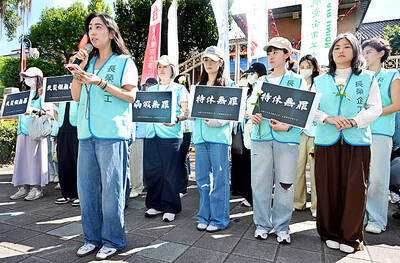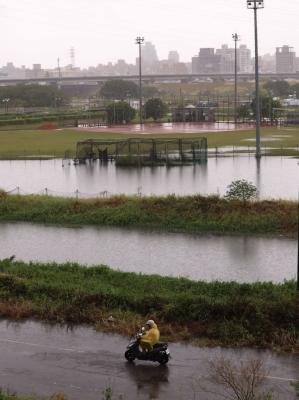A number of human rights groups — including the Taiwan Tibetan Welfare Association and the Regional Tibetan Youth Congress Taiwan — yesterday announced a series of events to commemorate the 56th anniversary of the 1959 Tibetan uprising, while advocating for the Tibetan cause to the world.
“It’s been more than half a century, and we Tibetans living in exile are still waiting for the opportunity to go home, while as many as 130 Tibetans living in Tibet and five living abroad self-immolated between 2009 and 2014 to protest the Chinese occupation of Tibet,” association president Tashi Tsering, a Tibetan, told a news conference at the Legislative Yuan.
“We would like to invite all Taiwanese to stand with us to remember those Tibetans who have been sacrificed, and to voice our call for a free Tibet,” Tashi said.
Tashi explained that on March 10, 1959, a demonstration by Tibetans in Lhasa to stop the Dalai Lama from accepting an invitation to see a drama performance in a Chinese military camp turned into an uprising against Chinese rule.
“The Dalai Lama was therefore forced to go into exile until today, while more than 1.2 million Tibetans inside Tibet were killed, and over 6,000 Buddhist monasteries were destroyed,” he said.
“Since then, we Tibetans have never ceased in our pursuit for a free Tibet, for the freedom of religion in Tibet and for the preservation of Tibetan culture,” Tashi said.
Chiu E-ling (邱伊翎), secretary-general of the Taiwan Association for Human Rights, said that as members of the global community who have shown much concern for human rights issues in the past few years, “We Taiwanese should not hesitate to join people around the world to speak out for the Tibetans.”
This year, events to commemorate the Tibetan uprising include a march that starts from MRT Zhongxiao Fuxing Station in Taipei at 2pm tomorrow, and another march in Kaohsiung that begins from Central Park (中央公園) at 6pm on Tuesday.
In addition, a candlelit vigil is planned to take place in Taipei’s Liberty Square at 7pm on Tuesday.

The Taoyuan Flight Attendants’ Union yesterday vowed to protest at the EVA Air Marathon on Sunday next week should EVA Airway Corp’s management continue to ignore the union’s petition to change rules on employees’ leave of absence system, after a flight attendant reportedly died after working on a long-haul flight while ill. The case has generated public discussion over whether taking personal or sick leave should affect a worker’s performance review. Several union members yesterday protested at the Legislative Yuan, holding white flowers and placards, while shouting: “Life is priceless; requesting leave is not a crime.” “The union is scheduled to meet with

‘UNITED FRONT’ RHETORIC: China’s TAO also plans to hold weekly, instead of biweekly, news conferences because it wants to control the cross-strait discourse, an expert said China’s plan to expand its single-entry visa-on-arrival service to Taiwanese would be of limited interest to Taiwanese and is a feeble attempt by Chinese administrators to demonstrate that they are doing something, the Mainland Affairs Council said yesterday. China’s Taiwan Affairs Office (TAO) spokesman Chen Binhua (陳斌華) said the program aims to facilitate travel to China for Taiwanese compatriots, regardless of whether they are arriving via direct flights or are entering mainland China through Hong Kong, Macau or other countries, and they would be able to apply for a single-entry visa-on-arrival at all eligible entry points in China. The policy aims

Taipei, New Taipei City, Keelung and Taoyuan would issue a decision at 8pm on whether to cancel work and school tomorrow due to forecasted heavy rain, Keelung Mayor Hsieh Kuo-liang (謝國樑) said today. Hsieh told reporters that absent some pressing reason, the four northern cities would announce the decision jointly at 8pm. Keelung is expected to receive between 300mm and 490mm of rain in the period from 2pm today through 2pm tomorrow, Central Weather Administration data showed. Keelung City Government regulations stipulate that school and work can be canceled if rain totals in mountainous or low-elevation areas are forecast to exceed 350mm in

EVA Airways president Sun Chia-ming (孫嘉明) and other senior executives yesterday bowed in apology over the death of a flight attendant, saying the company has begun improving its health-reporting, review and work coordination mechanisms. “We promise to handle this matter with the utmost responsibility to ensure safer and healthier working conditions for all EVA Air employees,” Sun said. The flight attendant, a woman surnamed Sun (孫), died on Friday last week of undisclosed causes shortly after returning from a work assignment in Milan, Italy, the airline said. Chinese-language media reported that the woman fell ill working on a Taipei-to-Milan flight on Sept. 22